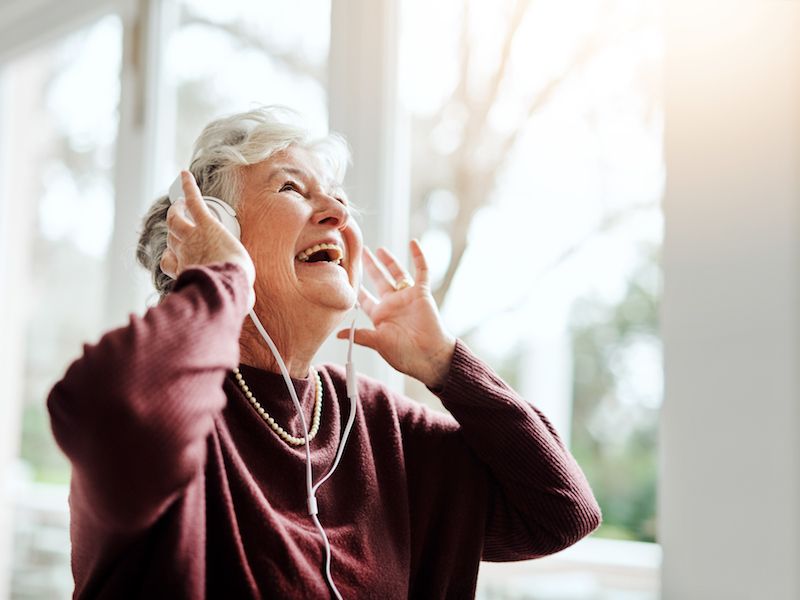
Noise-related hearing loss doesn’t only impact people who work in loud environments, like construction workers or heavy metal roadies. Leisure associated noise exposure can be just as harmful as work related noise exposure. What kind of exposure are we talking about? Loud noise heard through headphones, whether it’s gaming, streaming video, music, or even an audiobook with the volume turned up.
You might not realize your smartphone or tablet can get that loud. But these devices can achieve sustained volumes of over 105 dB, which is around the average human threshold for pain. Your ears will literally start to feel pain at this volume. So what’s the plan to safeguard against this type of noise-related hearing loss?
It’s relevant here to consider the volume. An easy shorthand that’s widely recommended is the 60/60 rule: Listen with the volume at no more than 60% for no more than 60 minutes at a stretch (because the length of sound exposure matters, too).
Your Hearing Aids Can be Set up For Music
Make sure, if you’re using hearing aids, you don’t attempt to drown out other noises by turning your streaming music up too high. And there are better ways to listen to music so ask us about that as well. If you’re a musician or real music aficionado you might have noticed that most hearing aids are created to improve the clarity of voices…not necessarily music. We might be able to make adjustments to minimize noise and feedback while increasing some frequency to improve the quality of sound while listening to music.
Selecting Headphones
If you don’t have hearing aids, there are a lot of choices for picking out headphones. It might be a matter of personal choice, but there are some things you will want to think about there as well.
Headphones That go Over The Ears
While the foam-covered speakers that came with your old Walkman are basically no longer used, over-the-ear headphones have made a comeback. Often unexpectedly pricey, they feature lots of color possibilities and celebrity endorsements, and of course, better sound quality. And these headphones go over the entire ear blocking out noise, unlike those old foam ones.
Conventional perception is that these are safer than in-ear headphones because the source of the sound is further away from your eardrum. But because the speakers are bigger they are often capable of much louder sound level. Noise cancellation can be a good thing as long as you’re not losing important sounds such as an oncoming car. With that being said, because they cancel out outside noise, you can often lower the volume of what you’re listening to so it’s not so loud that it will injure your hearing.
Earbuds
The normal earbuds that are included with devices such as iPhones are much maligned for their inferior quality of sound, but because they come with your phone many people still use them. In addition, with newer models that no longer have a headphone jack, sticking with Apple’s earbuds can simply be easier.
The drawback, aside from the inferior sound quality, is that basic earbuds don’t block outside sounds, so you’re more likely to crank up the sound level. Again, though it’s frequently said that earbuds are problematic because you put them in your ear so their speakers are very close to your eardrum, actually volume is really the biggest problem.
Noise Canceling Earbuds
More comfortable than regular earbuds, models with a round rubber tip are the choice of many because they help obstruct outside noise. The rubber molds to the shape of your ear, creating a seal that blocks other noises from entering. But these earbuds can also block out noises you need to hear and volume is still the biggest issue. And if you have hearing aids, obviously these won’t work for you.
You might have to check out quite a few pairs before you find headphones that work for you. Depending on what you regularly use them for talking on the phone, say, versus listening to music, you’ll have unique acoustic expectations. Enjoying your music at a healthy volume and coming across headphones that assist you in doing that is essential.
How to Make Sure Your Hearing is Safeguarded
Is it Safe, How Can I be certain? If you have a smartphone, you can get an app for that, you can download the National Institute for Occupational Safety and Health’s free Sound Level Meter app. You can get different apps, but studies has found that the dependability of these other apps is spotty (in addition, for reasons yet unknown, Android-based apps have been shown less precise). That motivated NIOSH to create an app of their own. The app lets you measure external sounds, but sounds coming from your device’s speakers can be measured too, so you will learn precisely how much volume your ears are getting. You have to do a little work, but taking these types of preventative steps can help protect your hearing.
